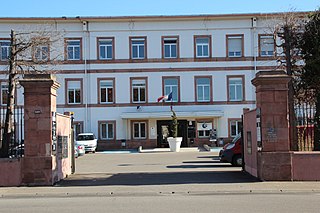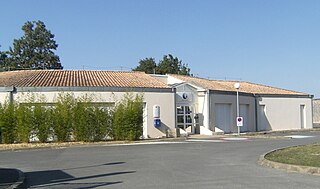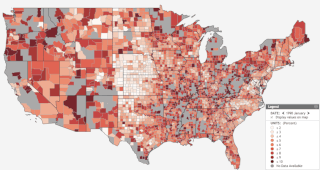Unemployment benefits, also called unemployment insurance, unemployment payment, unemployment compensation, or simply unemployment, are payments made by authorized bodies to unemployed people. In the United States, benefits are funded by a compulsory governmental insurance system, not taxes on individual citizens. Depending on the jurisdiction and the status of the person, those sums may be small, covering only basic needs, or may compensate the lost time proportionally to the previous earned salary.
Jobseeker's Allowance (JSA) is an unemployment benefit paid by the Government of the United Kingdom to people who are unemployed and actively seeking work. It is part of the social security benefits system and is intended to cover living expenses while the claimant is out of work.

Jobcentre Plus is part of the Department for Work and Pensions in the United Kingdom.
The Hartz concept, also known as Hartz reforms or the Hartz plan, is a set of recommendations submitted by a committee on reforms to the German labour market in 2002. Named after the head of the committee, Peter Hartz, these recommendations went on to become part of the German government's Agenda 2010 series of reforms, known as Hartz I – Hartz IV. The committee devised thirteen "innovation modules", which recommended changes to the German labour market system. These were then gradually put into practice: The measures of Hartz I – III were undertaken between January 1, 2003, and 2004, while Hartz IV was implemented on January 1, 2005.

The National Insurance Act 1911 created National Insurance, originally a system of health insurance for industrial workers in Great Britain based on contributions from employers, the government, and the workers themselves. It was one of the foundations of the modern welfare state. It also provided unemployment insurance for designated cyclical industries. It formed part of the wider social welfare reforms of the Liberal Governments of 1906–1915, led by Henry Campbell-Bannerman and H. H. Asquith. David Lloyd George, the Liberal Chancellor of the Exchequer, was the prime moving force behind its design, negotiations with doctors and other interest groups, and final passage, assisted by Home Secretary Winston Churchill.

Social security is divided by the French government into five branches: illness; old age/retirement; family; work accident; and occupational disease. From an institutional point of view, French social security is made up of diverse organismes. The system is divided into three main Regimes: the General Regime, the Farm Regime, and the Self-employed Regime. In addition there are numerous special regimes dating from prior to the creation of the state system in the mid-to-late 1940s.

The Agence nationale pour l'emploi, or ANPE was a French government agency which provided counseling and aid to those who are in search of a job or of training.
Welfare in France includes all systems whose purpose is to protect people against the financial consequences of social risks.
The domestic policy of the Nicolas Sarkozy administration was led by François Fillon's government as soon as the president was elected, and the government appointed by the president. According to the French constitution, the government and the Prime Minister "determine and conduct the policy of the nation", that is to say, deal with the domestic policy, while the President of the Republic focuses on foreign relations. However, a modification of the constitution in 2001 shortened the presidential mandate from seven to five years, so that the presidency lasts the same time as the government's mandate. Therefore, the president can be more implicated in the governmental policy. It was the case with Nicolas Sarkozy, who has been accused of being a "hyper-president" by his opponents. François Fillon appeared as too much submitted to the president.

Pôle emploi is a French governmental agency which registers unemployed people, helps them find jobs and provides them with financial aid. The agency was created in 2009, resulting from the merger between the ANPE and the ASSEDIC. The agency employs 45,000 civil servants. The merger had been expected for a very long time, for the two agencies had been created more than forty years before.
UNEDIC is the acronym of "Union nationale interprofessionnelle pour l’emploi dans l’industrie et le commerce". It was created in 1958. Until 2009, it was an agency of the French government which provided unemployed people with social benefits. In 2009, it was merged with the ANPE into the newly created agency Pôle emploi, and was turned into an independent association.

Assédic is the partial acronym of "Association pour l’emploi dans l’industrie et le commerce". Created in 1958, it was a French agency that collected and paid unemployment insurance contributions. It was associated with the UNEDIC agency, which set the amount of the contributions. In 2009, it was merged with the ANPE into the new agency Pôle emploi.

Unemployment in the United Kingdom is measured by the Office for National Statistics and in the three months to May 2017 the headline unemployment rate stood at 4.5%, or 1.49 million people. This is a reduction in unemployed people of 152,000 from a year earlier, and is the lowest jobless rate since 1975. The ONS said the employment rate, or percentage of people in work for those aged between 16 and 64, was 74.9% for the three months to May. This is the highest employment rate since comparable records began in 1971. There were 32.01 million people in work, 324,000 more than a year earlier.
Social security in Germany is codified on the Sozialgesetzbuch (SGB), or the "Social Code", contains 12 main parts, including the following,
Unemployment insurance, also known as 失業保険, is the "user pays" system of unemployment benefits that operates in Japan. It is paired with Workers' Accident Compensation Insurance and referred to collectively as Labour insurance. It is managed by Hello Work.
The Swiss pension system rests on three pillars:
The Sozialversicherungen in Switzerland includes several public and private insurance plans to assist the welfare of the population.

Unemployment insurance in the United States, colloquially referred to as unemployment benefits, refers to social insurance programs which replace a portion of wages for individuals during unemployment. The first unemployment insurance program in the U.S. was created in Wisconsin in 1932, and the federal Social Security Act of 1935 created programs nationwide that are administered by state governments. The constitutionality of the program was upheld by the Supreme Court in 1937.
Denmark is a Scandinavian country in Europe consisting of the Jutland Peninsula and numerous islands. Typically, Denmark has had relatively low unemployment rates. Currently, Denmark has generous unemployment benefits in the form of private insurance funds. Unemployment benefits are typically payments made by the state or other authorized actors to unemployed persons.
Unemployment benefits in the Philippines are payments made by the government to unemployed people. The unemployment benefits provided by the Philippine government is sourced either from the country's Social Security System (SSS) or the Government Service Insurance System (GSIS).







